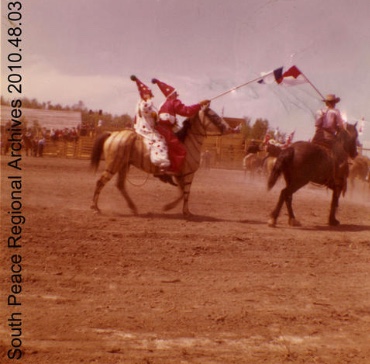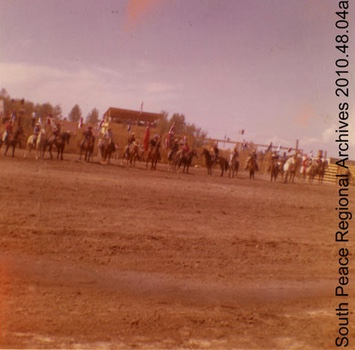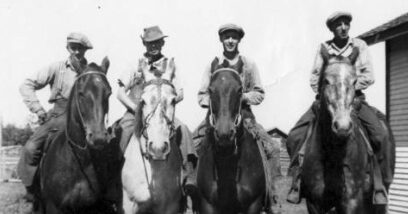Rodeo and horsemanship events have been a part of this region since it was first settled. Many rodeos and stampedes were originally created as an event to get away from the regular stresses of farm and ranch life. Rodeos and stampedes were an opportunity for the community to come together, participate in games and amusements and sometimes use the skills and horsemanship talents from farm work to compete against other rodeo athletes. Most rodeos and stampedes not only had events for cowboys, but they also had events for kids which was entertaining for everyone.
Bezanson has always had roots in the farm and ranch way of life and it also has a lengthy history of being a social community. From its very beginnings down at the townsite, community races, sports days and picnics were a regular occurrence. It is fitting then, that Bezanson in later years also hosted rodeo events in its annual Stampede, “The Biggest Little Rodeo”. The rodeo grounds were located in the area where the Bezanson ball diamonds and curling rink sit today. “The shoots were on the west side of the arena while the horses bucked out of the east side, there was a covered barn and the bleachers were on the east side around the corral,” Henry Diederich reflects on his days being involved in the Stampede.
The Bezanson Stampede was an annual event from 1947 – 1962 in the hamlet of Bezanson. The event brought together many people from the surrounding area for an event that included calf roping, cow hide races, wild cow milking, potatoe races, saddle bronc, kids rodeo events and more! This event did not include bull riding! Although there is not a lot of information about the Bezanson Stampede, I sat down with a few of the people that volunteered to make the event happen: Grant and Margaret Moon as well as Henry Diederich. Grant was the President of the Stampede back in the day, he and Margaret were tireless volunteers in the Stampede event, and Henry was the announcer from 1947-1962.
The Stampede at Bezanson was full of activities: carnival, rides, Ferris wheel, as well as a couple of food booths complete with pies, hot dogs, hamburgers. Grant recalls that, “One year they had Coca-cola and the next year it was Pepsi-cola. This alternated every year.” Children’s games and events were a part of Stampede Day also. Roy Robideau did most of the organizing for the kid’s games during the rodeo years. They had a supper in the evening for sale, then a dance.
Grant and Margaret also remember how the money from the stampede (after it had stopped running) was given to the hall group. The hall was an important part of the community that everyone made use of; dances, meetings, movie theatre. Margaret says,” Everyone paid for stampede, even the workers (volunteers). Dances at the hall men: $1, women: free. Dances started at 10 PM, swept at 12 AM, midnight dinner at 12 AM for 30 minutes and these dances would last until around 2-3 AM. Music was performed by locals such as Earl Patterson, Bredesons, Fords and Dwayne Stark.”
The rodeo portion of the event included wild cow milking, mutton busting, calf-roping, potato races, cow hide races, cow riding (instead of bull riding), bucking bronc-bare back, stake races and barrel races. Neither the Moons nor Henry remember a human corral for the rodeo but when it ran in the hamlet, there was a fence up. The Moons remember that, “Henry Diederich was the last announcer, Johnny Stark before Henry.” They also remembered that, “Bud Patterson rode around on his horse with a cone and shouted out the announcing in the arena.”

The stock used for the rodeo came from local farms originally. The animals were branded to keep track of them. In the last few years the Stampede organizers bought horses, which after Teepee Stampede bought horses too, were traded back and forth for the events. Many local farmers supplied stock for the event. Henry remembers bucking stock supplied by Bob Frakes and cattle supplied by Bob Mcfee, Hap McLaughlin, Pete and Charlie Moon.
One of the memorable stories from the Bezanson Stampede was the infamous Bezanson Gravedigger. It was deemed the wildest horse. Henry remembers, “Delmer Weegar used to ride. Once when the others were chicken to get on the Bezanson Gravedigger, Delmer volunteered. He probably would have ridden it too if he hadn’t hooked his foot on the gate on the way out.”
On top of the all of the riding events, the Bezanson Stampede also held the Pleasure Class and Glamour Class. This is where they would dress in costume and show off their horses around the corral. There were cash prizes for these groups and even a trophy for the winner. Grant remembers the last trophy possibly going to someone that was from Fort St. John.

Rodeo clowns Delmer and David Weegar on horseback at Bezanson Stampede.
Rodeo clowns at Bezanson Stampede.
Courtesy of South Peace Regional Archives CA GPR 0502-2010.48.03
Henry reminisces, “The Stampede was like a big family event with everyone coming. There were lots of locals with the odd out of towners. It was the biggest event of the year, everyone came and many people camped.” Hosting a big event took a lot of volunteer effort. Grant recalls, “Ten days work to get it ready, and then take it all down. A lot of work. [We had to] find people to work in booths and to volunteer.”
When asked as to why the Stampede in Bezanson didn’t have a longer run, Grant Moon replied, “Not sure, maybe the lack of interest or it was too much work for one day. It was not because of the Teepee Creek Stampede. Guys would come from Teepee and help Bezanson and then vice versa. They always worked together with the stampedes.” Henry Diederich recalls that the decision made to discontinue with the stampede was also due to the need to upgrade the chutes and rodeo grounds and the lack of funds to do so.
The communities of Teepee Creek and Bezanson worked together for their stampedes. This was very important because then they were able to have more volunteers and even more horses at each of their stampedes. These communities that worked together helped each other grow and develop. They provided the assistance to help one another complete a huge event for each community. Although the stampede did not continue past 1962, the community had a successful rodeo for the little while they had and that brought them together as a community.

Stampede Day showing entire Bezanson Stampede Grounds in 1957
Courtesy of South Peace Regional Archives CA GPR 0502-2010.48.04a
Featured Image
1945 Stampede Time at Bezanson showing the cowboys Harvey Weegar, Don Stark, Desmond Stark and Jim Stark.
Photo Courtesy of South Peace Regional Archives CA GPR 0502-2010.48.01

